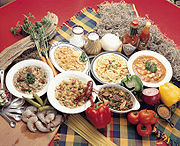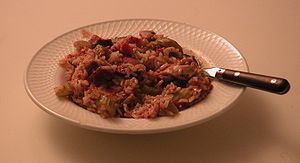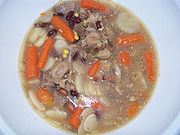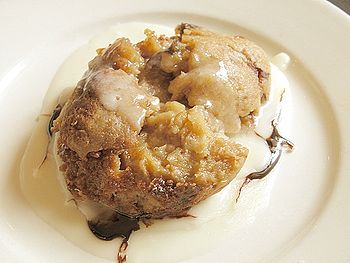
Louisiana Creole cuisine
Encyclopedia


Cooking
Cooking is the process of preparing food by use of heat. Cooking techniques and ingredients vary widely across the world, reflecting unique environmental, economic, and cultural traditions. Cooks themselves also vary widely in skill and training...
originating in Louisiana
Louisiana
Louisiana is a state located in the southern region of the United States of America. Its capital is Baton Rouge and largest city is New Orleans. Louisiana is the only state in the U.S. with political subdivisions termed parishes, which are local governments equivalent to counties...
which blends French
French cuisine
French cuisine is a style of food preparation originating from France that has developed from centuries of social change. In the Middle Ages, Guillaume Tirel , a court chef, authored Le Viandier, one of the earliest recipe collections of Medieval France...
, Spanish
Spanish cuisine
Spanish cuisine consists of a variety of dishes, which stem from differences in geography, culture and climate. It is heavily influenced by seafood available from the waters that surround the country, and reflects the country's deep maritime roots...
, Portuguese
Portuguese cuisine
Portuguese cuisine is characterised by rich, filling and full-flavored dishes and is closely related to Mediterranean cuisine. The influence of Portugal's former colonial possessions is also notable, especially in the wide variety of spices used. These spices include piri piri and black pepper, as...
, Italian
Italian cuisine
Italian cuisine has developed through centuries of social and political changes, with roots as far back as the 4th century BCE. Italian cuisine in itself takes heavy influences, including Etruscan, ancient Greek, ancient Roman, Byzantine, Jewish and Arab cuisines...
, Greek, Asian Indian
Indian cuisine
Indian cuisine consists of thousands of regional cuisines which date back thousands of years. The dishes of India are characterised by the extensive use of various Indian spices, herbs, vegetables and fruit. Indian cuisine is also known for the widespread practice of vegetarianism in Indian society...
, Native American, and African influences, as well as general Southern cuisine. It is similar to Cajun cuisine
Cajun cuisine
Cajun cuisine is the style of cooking named for the French-speaking Acadian or "Cajun" immigrants deported by the British from Acadia in Canada to the Acadiana region of Louisiana, USA. It is what could be called a rustic cuisine — locally available ingredients predominate, and preparation...
in ingredients (such as the holy trinity
Holy trinity (cuisine)
The holy trinity is the Cajun and Louisiana Creole variant of mirepoix: onions, bell peppers, and celery in roughly equal quantities. This mirepoix is the base for much of the cooking in the regional cuisines of Louisiana...
), but the important distinction is that Cajun cuisine arose from the more rustic, provincial French cooking adapted by the Acadian
Acadian
The Acadians are the descendants of the 17th-century French colonists who settled in Acadia . Acadia was a colony of New France...
s to Louisiana ingredients, whereas the cooking of the Louisiana Creoles
Louisiana Creole people
Louisiana Creole people refers to those who are descended from the colonial settlers in Louisiana, especially those of French and Spanish descent. The term was first used during colonial times by the settlers to refer to those who were born in the colony, as opposed to those born in the Old World...
tended more toward classical European styles adapted to local foodstuffs. Broadly speaking, the French influence in Cajun cuisine is descended from various French Provincial cuisines of the peasantry, while Creole cuisine evolved in the homes of well-to-do aristocrats, or those who imitated their lifestyle. Although the Creole cuisine is closely identified with New Orleans culture today, much of it evolved in the country plantation estates so beloved of the pre-Civil War Creoles. (Despite its aristocratic French roots, Creole cuisine does not include Garde Manger
Garde manger
Garde manger , meaning "keep to eat" refers to a cool, well-ventilated area where cold dishes are prepared and other foods are stored under refrigeration...
or other extremely lavish styles of the Classical Paris cuisine.)
Overview
The Spanish, Italian, and Canarian influences on Creole cuisine were in the heat of the peppersChili pepper
Chili pepper is the fruit of plants from the genus Capsicum, members of the nightshade family, Solanaceae. The term in British English and in Australia, New Zealand, India, Malaysia and other Asian countries is just chilli without pepper.Chili peppers originated in the Americas...
, the wide usage of citrus juice marinades, the supreme importance of rice, and the introduction of beans. The Spaniards and the Italians also used tomatoes extensively, which had not been a frequent ingredient in the earlier French era. Pasta and tomato sauces arrived during the period when New Orleans was a popular destination for Italian, and Greek immigrants (roughly, 1815 to 1925). Many Italians and Greeks became grocers, bakers, cheese makers and orchard farmers, and so influenced the Creole cuisine in New Orleans and its suburbs. The African and Indian influences, which were extensive, came about because many of the servants were either African-American or Asian Indian American, as were many of the cooks in restaurants and cafes.
The first French, Spanish and Portuguese Creole cookbooks date back to the era before the Louisiana Purchase. The first Creole cookbook in English was La Cuisine Creole: A Collection of Culinary Recipes, From Leading Chefs and Noted Creole Housewives, Who Have Made New Orleans Famous For Its Cuisine, written by Lafcadio Hearn
Lafcadio Hearn
Patrick Lafcadio Hearn , known also by the Japanese name , was an international writer, known best for his books about Japan, especially his collections of Japanese legends and ghost stories, such as Kwaidan: Stories and Studies of Strange Things...
and published in 1885.
By that time Creole was already an identifiable regional cuisine recognized outside Louisiana: for example, an 1882 Florida hotel menu now in the New York Public Library
New York Public Library
The New York Public Library is the largest public library in North America and is one of the United States' most significant research libraries...
's collection offered "Chicken Saute, á la Creole."
Starting in the 1980s, Cajun
Cajun
Cajuns are an ethnic group mainly living in the U.S. state of Louisiana, consisting of the descendants of Acadian exiles...
influence became important, spurred by the popular restaurant of Chef Paul Prudhomme
Paul Prudhomme
Paul Prudhomme is an American celebrity chef whose specialty is Cajun cuisine. He is also the owner of one of the top restaurants in New Orleans, K-Paul's Louisiana Kitchen.-Early life:...
. A national interest in Cajun cooking developed, and many tourists
Tourism
Tourism is travel for recreational, leisure or business purposes. The World Tourism Organization defines tourists as people "traveling to and staying in places outside their usual environment for not more than one consecutive year for leisure, business and other purposes".Tourism has become a...
went to New Orleans expecting to find Cajun food there (being unaware that the city was culturally and geographically separate from Acadiana
Acadiana
Acadiana, or The Heart of Acadiana, is the official name given to the French Louisiana region that is home to a large Francophone population. Of the 64 parishes that make up Louisiana, 22 named parishes and other parishes of similar cultural environment, make up the intrastate...
), so entrepreneurs opened or rebranded restaurants to meet this demand. The "New New Orleans Cooking" of celebrity chef Emeril Lagasse
Emeril Lagasse
'Emeril John Lagasse is an American celebrity chef, restaurateur, television personality, and cookbook author. A regional James Beard Award winner, he is perhaps most notable for his Food Network shows Emeril Live and Essence of Emeril as well as catchphrases such as “Kick it up a notch!” and...
includes both Cajun and Creole dishes. In his writings and TV shows, Lagasse both draws the distinction between Cajun and Creole and explains where they overlap.
With the rise of southern American Cooking in the 1980s, a New Creole (or Nouvelle Creole) strain began to emerge. This movement is characterized in part by a renewed emphasis on fresh ingredients and lighter preparations, and in part by an outreach to other culinary traditions, including Cajun, Southern, Southwestern, and to a lesser degree Southeast Asian. While the Cajun food craze eventually passed, Modern Creole has remained as a predominant force in most major New Orleans restaurants.
Appetizers
- Crabmeat Ravigote
- Oysters Bienville
- Oysters en BrochetteOysters en BrochetteOysters en brochette is a classic dish in New Orleans Creole cuisine. Raw oysters are skewered, alternating with pieces of partially cooked bacon. The entire dish is then breaded and then either deep fried or sautéed. The traditional presentation is on triangles of toast with the skewer removed...
- Oysters RockefellerOysters RockefellerOysters Rockefeller consists of oysters on the half-shell that have been topped with various other ingredients and are then baked or broiled.-History:...
- Shrimp RemouladeRemouladeRemoulade or rémoulade, invented in France, is a popular condiment in many countries. Very much like the tartar sauce of some English-speaking cultures, remoulade is often aioli- or mayonnaise-based. Although similar to tartar sauce, it is often more yellowish , often flavored with curry, and...
Soups

- Crawfish Bisque
- GumboGumboGumbo is a stew or soup that originated in southern Louisiana during the 18th century. It consists primarily of a strongly-flavored stock, meat or shellfish, a thickener, and the vegetable holy trinity of celery, bell peppers, and onions...
- Oyster and Artichoke Bisque
- Yakamein
- Turtle SoupTurtle soupTurtle soup is soup or stews made from the flesh of the turtle. The dish exists in many cultures and is viewed as a luxury or delicacy.The green turtle was commonly used for turtle soup in the United States and United Kingdom. Soup made from the snapping turtle was found mainly in the United States...
- Oxtail SoupOxtail soupOxtail soup is made with beef tails. The use of the word "ox" in this context is a legacy of nomenclature; no specialized stock of beef animals are used...
Main dishes
- Crawfish étoufféeÉtoufféeÉtouffée or etouffee is a dish found in both Cajun and creole cusine typically served with shellfish over rice. It is most popular in New Orleans and in the bayou country of the southernmost half of Louisiana.-Etymology:...
- JambalayaJambalayaJambalaya is a Louisiana Creole dish of Spanish and French influence. -Jambalaya varieties:Jambalaya is traditionally made in three parts, with meats and vegetables, and is completed by adding stock and rice. It is also a close cousin to the saffron colored paella found in Spanish culture...
- Crawfish Fettuccine
- Pompano en PapillotePompano en PapillotePompano en Papillote is a dish created by Jules Alciatore at Antoine's Restaurant in New Orleans for a banquet honoring the Brazilian balloonist Alberto Santos-Dumont. The dish was based in turn on a dish that Jules's father Antoine Alciatore had created—Pompano Montgolfier--honoring the brothers...
- Red Beans and RiceRed beans and riceRed beans and rice is an emblematic dish of Louisiana Creole cuisine traditionally made on Mondays with red beans, vegetables , spices and pork bones as left over from Sunday dinner, cooked together slowly in a pot and served over rice...
- Shrimp CreoleShrimp CreoleShrimp creole is a dish of Louisiana Creole origin , consisting of cooked shrimp in a mixture of whole or diced tomatoes, onion, celery and bell pepper, spiced with Tabasco sauce or another hot pepper sauce and/or cayenne-based seasoning, and served over steamed or boiled white rice...
- Chicken Creole
- Trout MeuniereMeuniere sauceMeunière or , French ) refers to both a sauce and a method of preparation, primarily for fish. The word itself means "miller's wife". Thus to cook something à la meunière was to cook it by first dredging it in flour...
- Sauce Piquante
- Stuffed Bell Peppers
- Blackened Salmon
- Mirliton
- Creole Baked Chicken
- Shrimp Bisque
- Quiche
- Smothered Pork Chops/Steak
- Potato Salad
Side Dishes
- Maque chouxMaque chouxMaque choux is a traditional dish of southern Louisiana. It is thought to be an amalgam of Acadian French and American Indian cultural influence, and the name is likely to derive from the French interpretation of the Native American name....
- Red Beans
- Dirty RiceDirty riceDirty rice is a traditional Cajun dish made from white rice cooked with small pieces of chicken liver or giblets, which give it a dark color and a mild but distinctive flavor. Similar to a pilaf, it also includes green bell pepper, celery and onion . Parsley and/or chopped green onions are common...
- Green Beans w/Potatoes
Desserts

- Bananas FosterBananas FosterBananas Foster is a dessert made from bananas and vanilla ice cream, with the sauce made from butter, brown sugar, cinnamon, dark rum, and banana liqueur. The butter, sugar and bananas are cooked, and then the alcohol is added and ignited. The bananas and sauce are then served over the ice cream...
- Bread puddingBread puddingBread pudding is a bread-based dessert popular in many countries' cuisine, including that of Great Britain, France, Belgium, Puerto Rico, Mexico, Malta, Argentina, Louisiana Creole, and the southern United States...
- BeignetBeignetA beignet in the U.S. is a pastry made from deep-fried dough, much like a doughnut, and sprinkled with confectioner's sugar, or frostings. Savory versions of beignets are also popular as an appetizer, with fillings such as maple or fruit preserves....
s - King CakeKing cakeA king cake is a type of cake associated with the festival of Epiphany in the Christmas season in a number of countries, and in other places with the pre-Lenten celebrations of Mardi Gras / Carnival...
- Doberge cakeDoberge cakeDoberge cake is a layered dessert originating in New Orleans, Louisiana. Still popular in the area, the cake is made of multiple thin layers of cake alternating with dessert pudding. Very often the cakes are made with half chocolate pudding and half lemon pudding. They are covered in a thin layer...
- Pralines
- Pecan PiePecan piePecan pie is a sweet pie made primarily of corn syrup and pecan nuts. It is popularly served at holiday meals and is also considered a specialty of Southern U.S. cuisine. Most pecan pie recipes include salt and vanilla as flavorings. Chocolate and bourbon whiskey are other popular additions to the...
- Banana Pudding
- Peach CobblerCobbler (food)thumb|Apple Cobbler.Cobbler refers to a variety of dishes, particularly in the United States and United Kingdom, consisting of a fruit or savoury filling poured into a large baking dish and covered with a batter, biscuit, or pie crust before being baked...
- Blackberry Cobbler
Beverages
- Café Brûlot
- Café au laitCafé au laitCafé au lait is a French coffee drink. The meaning of the term differs between Europe and the United States; in both cases it means some kind of coffee with hot milk added, in contrast to white coffee, which is coffee with room temperature milk or other whitener added.- Europe :In Europe, "café au...
- Ramos Gin Fizz
- Sazerac cocktail
Breakfast
- CalasCalas (food)Calas are deep fried rice cakes, made with sugar, flour, eggs and rice. It was a popular breakfast food in New Orleans in the early twentieth century, and has a mention in most Creole cuisine cookbooks....
- Eggs SardouEggs SardouEggs Sardou is a Louisiana Creole cuisine dish made with poached eggs, artichoke bottoms, creamed spinach and Hollandaise sauce. It is on the menu of many Creole restaurants in New Orleans, including Antoine's, where Eggs Sardou was invented, and Brennan's...
- Grits and GrilladesGrits and grilladesGrits and grillades , sometimes grillades and grits, are a traditional New Orleans dish generally served at breakfast or brunch. The recipe can vary to include beef, veal or pork; any of which would be slow cooked with vegetables and served over grits....
- French toastFrench toastFrench toast or Eggy Bread, is a food made with bread and eggs. It is a Christmas time dessert in Portugal and Brazil.Where French toast is served as a sweet dish, milk, sugar, or cinnamon are also commonly added before frying, and it may be then topped with sugar, butter, fruit, syrup, or other...
(Pain perdu)
See also
- Austin LeslieAustin LeslieAustin Leslie was an internationally famous New Orleans chef whose work defined 'Creole Soul'. He died in Atlanta at the age of 71 after having been evacuated from New Orleans; he had been trapped in his attic for two days in the 98°F heat in the aftermath of the 29 August Hurricane Katrina...
- Cuisine of the United StatesCuisine of the United StatesAmerican cuisine is a style of food preparation originating from the United States of America. European colonization of the Americas yielded the introduction of a number of ingredients and cooking styles to the latter...
- Southern U.S. cuisine
- BarbecueBarbecueBarbecue or barbeque , used chiefly in the United States, Canada, the United Kingdom, New Zealand and Australia is a method and apparatus for cooking meat, poultry and occasionally fish with the heat and hot smoke of a fire, smoking wood, or hot coals of...
- Cajun cuisineCajun cuisineCajun cuisine is the style of cooking named for the French-speaking Acadian or "Cajun" immigrants deported by the British from Acadia in Canada to the Acadiana region of Louisiana, USA. It is what could be called a rustic cuisine — locally available ingredients predominate, and preparation...
- Cuisine of QuebecCuisine of QuebecQuebecs traditional cuisine is today being rediscovered and is as rich and diverse as Quebec itself. The historical context of 'traditional' Quebec cuisine is from the fur trade period and many dishes have a high fat or lard content...
- CookingCookingCooking is the process of preparing food by use of heat. Cooking techniques and ingredients vary widely across the world, reflecting unique environmental, economic, and cultural traditions. Cooks themselves also vary widely in skill and training...
- CuisineCuisineCuisine is a characteristic style of cooking practices and traditions, often associated with a specific culture. Cuisines are often named after the geographic areas or regions that they originate from...
New Orleans restaurants
- Antoine'sAntoine'sAntoine's is a Louisiana Creole cuisine restaurant located at 713 rue St. Louis in the French Quarter of New Orleans, Louisiana. It has the distinction of being the oldest family run restaurant in the United States, having been established in 1840 by Antoine Alciatore...
- Restaurant August
- Cochon
- Arnaud'sArnaud'sArnaud's is a well known restaurant in New Orleans, Louisiana, USA. Along with Galatoire's, Antoine's, and Broussard's, Arnaud's is one of the four classic Creole New Orleans restaurants....
- Galatoire'sGalatoire'sGalatoire's is a restaurant at 209 Bourbon St. in the French Quarter of New Orleans, Louisiana, USA .Galatoire's Restaurant was founded in 1897 by Jean Galatoire, an immigrant from a small village near Pau, France in the foothills of the Pyrenees Mountains. The restaurant is still run by his fourth...
- Brennan'sBrennan'sBrennan's is a creole restaurant in the French Quarter of New Orleans, Louisiana. It is known for its lavish breakfast and for the creation of Bananas Foster.-History:...
- Commander's PalaceCommander's Palace-History:It was built in 1880. It is located in the Garden District of Uptown New Orleans , and is owned by the Brennan family. It has long been one of the best regarded upscale restaurants in the city. Paul Prudhomme and Emeril Lagasse are two of its most famous alumni who have worked in its...
- Dooky Chase'sLeah ChaseLeah Chase is a New Orleans chef, author and television personality. A daughter of the same name is a professional singer; see Leah Chase ....
- Hubig's New Orleans Style PiesHubig's New Orleans Style PiesHubig's New Orleans Style Pies are a brand of fruit and sweet-filled fried pies produced by the Simon Hubig Pie Company in New Orleans, Louisiana.-History:...
External links
- The full text and page images of Lafcadio Hearn's La Cuisine Creole can be found here at Feeding America: The Historic American Cookbook Project.
- The full text and page images of Célestine Eustis's Cooking in Old Creole Days can be found here at Feeding America: The Historic American Cookbook Project.
- Index of Creole & Cajun Recipes at Nola Cuisine

